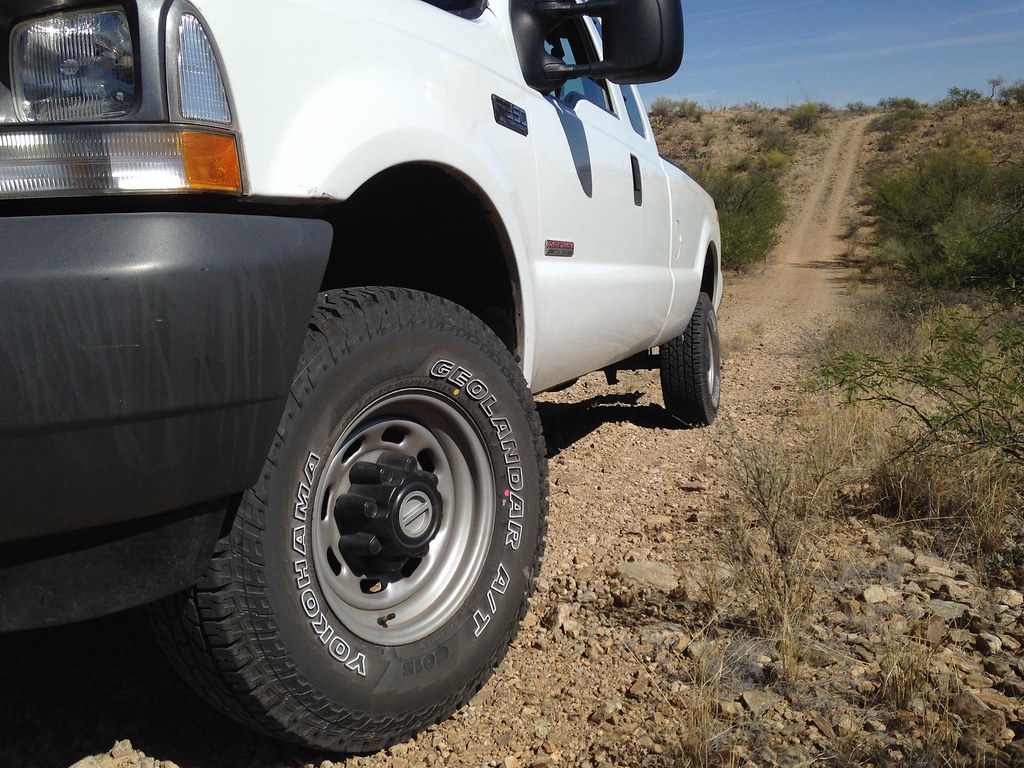
Overland Tech and Travel
Advice from the world's
most experienced overlanders
tests, reviews, opinion, and more
Buy the tire you need, not the one you want
Recently I received a set of the all-new Yokohama Geolandar AT GO15 tires to review for OutdoorX4 magazine. While sold as an “all terrain” tire, the tread on this Geolandar looks mild compared to many similarly marketed tires. And that got me to thinking about overlanders and our tire choices.
It’s natural to gravitate toward an aggressive tread design when buying tires for a four-wheel-drive vehicle. A more aggressive tread means better traction in steep or loose terrain, right?—which is why we have four wheel drive in the first place, right? And besides—let’s be honest—a mud-terrain tire just looks cooler than a more street-oriented “AT” tire. If appearance has never, ever entered into your tire-buying decision you’re a more logical thinker than I am.
Obviously, however, there are logical aspects to tire selection besides traction. The most critical of these—in fact the most critical of all— is safety. A street-biased tire with more closely spaced, shallower tread blocks will exhibit significantly better grip for both handling and braking than one with hyper-aggressive, open-blocked tread. That aspect could quite literally be a lifesaver in the right (wrong) scenario.
Fuel economy is a factor as well. When I switched from BFG All-Terrains to BFG Mud-Terrains on my FJ40 (partially because, yep, they just looked better) my fuel economy dropped by almost exactly one mile per gallon—and one mile per gallon on an FJ40 makes a difference, let me tell you. Then there’s tread life. Those closer tread blocks translate to less squirm, which translates to longer tread life given the same compound. Finally, even with modern computer-designed tread, aggressive tires tend to be louder at high speed, which can be a fatigue factor on long drives.
All these advantages to street-biased tires are obviously mostly advantageous on the street, and that’s where logic butts up against romance. Most of like to think we spend more time off pavement than we actually do. The reality is, if more than ten percent of the miles you put on your overland vehicle are actually off pavement, you are quite an adventurer. I’m not sure Roseann and I hit that, and we cover seven miles of dirt road just to reach our house. Much more frequently a backcountry journey will entail several hundred miles of highway and maybe 40 or 50 miles of trails. Thus, for most of us, for most of our time behind the wheel we would enjoy better handling, braking, fuel economy, and tread life with a less-aggressive tire choice. And we wouldn’t have to crank up the sound system so much to count how many times Terry Gross says “like” or “um” in one interview. Sorry, personal gripe.
Where was I? Right: There’s an additional factor to consider for those of us who own modern vehicles with sophisticated ABS-based traction systems and hill-descent control: We have more and better inherent traction available to us than we did when driving older vehicles with simple part-time four-wheel-drive systems. So we can enjoy just as much off-pavement ability with a less-aggressive tire—as anyone can confirm who’s watched Land Rover’s LR4s on street tires negotiate the Overland Expo driving course.
So the next time you buy tires for your overland vehicle, consider carefully—and logically. Do you really need those BFG Mud-Terrains, or would the All-Terrains perform better most of the time? For that matter, would BFG’s Rugged Trail suit your needs? Get the tire that works best, not the one that looks best. Then you can smile condescendingly at the guy driving by in the jacked up truck riding on those howling Super Swampers.
2015 Continental Divide vehicle report
Last year, the 1600 miles of the RawHyde/Exploring Overland Continental Divide trip proved to be a challenge for the participating vehicles (report here). This year’s journey proved just as challenging, in different ways. In no particular order the nine vehicles along this time were:
- 2008 Ford F350 6.4 diesel double-cab pickup
- 2012 Toyota Tacoma 4.0 V6 with Four Wheel Camper (our JATAC)
- 2010 Toyota Tacoma double-cab 4.0 V6 supercharged, with canvas bed shell
- 2014 Ram Power Wagon double-cab with Four Wheel Camper
- Ford Raptor with Four Wheel Camper
- 2014 Ford Raptor with Northstar camper
- 2009 Sportsmobile on a Ford 6.0 diesel chassis
- Toyota Tundra with fiberglass shell and roof tent
- 2008 Toyota Land Cruiser 200-Series with roof tent
For the first couple of days we seemed to be getting off lightly—the worst issue to surface was a burned out turn signal bulb in the aftermarket headlamp assembly on Ross Blair’s Tacoma. But somewhere north of Grants, New Mexico, Michael and Darla’s Raptor/FWC combination blew the Firestone air bag on the right rear spring on a long off-pavement section, causing the bag’s internal bump stops to slam against each other over the mildest terrain. Inspection revealed that the air bag was the longer of the two offered for the Raptor by Firestone—probably a mistake with a camper mounted. It appeared that repeated stressing of the bag being folded over the lower location cone caused the hole—a worrying failure given the mere days-old installation. Much worse was the unbelievably shoddy installation by Desert Rat Off Road Center in Tucson. The over-long U-bolts securing the lower brackets had been left untrimmed, so they impacted the spring perches when the suspension flexed, bending them and smashing the upper threads. Phil Westergren, our ace group mechanic, advised Michael that the best approach might be to simply remove both bags and let the truck sag; when Phil did so, he found the nuts on both U-bolts finger tight. Disappointing.
With both bags removed, the compliant Raptor suspension did droop noticeably, but retained far more travel than had been available with the collapsed bag left in place, so Michael and Darla were able to continue along with us. (Interestingly, Dennis and Margie, also in a Raptor with a heavier Northstar camper, had the same bags and had no issues the entire trip.)
Day four brought us to a fairly challenging boulder-strewn uphill section on a Forest Service road. I climbed in the passenger seat of the Sportsmobile to offer Marka some in-cab hints on wheel placement, but it soon became apparent the vehicle was suffering a distinct lack of traction, as she failed to climb several off-camber sections. Indeed, Phil, who was marshalling, reported that the front wheels were not getting power even though the (manual) hubs were locked, the driveshaft was turning, and as far as I could determine from inside the Atlas transfer case was correctly engaged. Fortunately the Sportsmobile had an automatic rear locker—and thus full traction to both rear wheels—so we were able to get Marka through the difficult section. But it presaged more significant problems on the icy and muddy sections we knew would be ahead. This was another issue we had no time to investigate thoroughly on the trail—the constraints of a paid trip.
After camping next to Elk Creek (Colorado), we attempted to drive up over Elwood Pass. However, we began encountering snow patches even lower than last year, and soon Phil decisively stuffed his F350 into a three-foot-deep bank completely covering the roadway, halting his and our further progress. With a quick KERR tug from Ross’s Tacoma (eliciting the expected comments from the Toyota drivers), we bailed and headed for Salida, the town beneath the 10,000-foot grass plateau on which the RawHyde Colorado camp sits.
Marshaling a kinetic recovery from a safe distance.
Reports indicated that, despite recent snowfall and rain, the back dirt route was clear, so we headed up the road through the San Isabel National Forest. As usual, Roseann and I took the tailgunner position to keep an eye out for any BF-109s tracking us with their MG 17s. No, wait, that’s not right. In this case, “tailgunner” just means making sure no one gets lost.
For ten miles or so the climb was uneventful—there were a few areas of slick mud and flowing ditches on the side, but nothing challenging—we were continually hitting lucky weather windows on this trip.
Then, after an easy creek crossing that led to a slight uphill section where water cut across the road and a ditch on the right carried it off, the two-meter crackled, and Cheryl in the Power Wagon said, “Um, I think I’m stuck,” to which Ross immediately replied, “No, you are definitely, absolutely stuck.” She had taken too low a line to cross the water-filled ruts in the road, and the massive truck with its mounted camper had slid into the ditch.
First try at towing, which would fail decisively.
The axiomatic approach in such situations is to begin recovery with the simplest technique, then work upwards in complexity and potential risk. A simple pull from Phil and his F350 had zero effect, so I replaced Cheryl in the driver’s seat and we rigged a kinetic rope between the trucks. Phil gave me some slack, backed up smartly but not quickly—and the truck moved.
For about 15 feet. I was trying to turn it out of the ditch, but the slope sucked in the front tires and Phil’s truck spun to a halt—not helped by me staying on the Ram’s throttle for just a second too long, further burying the right rear tire in the muck if it needed further burying.
Time for the winch, but first Roseann left to drive ahead with the rest of the group to the RawHyde camp, while Phil, Ross, Kevan, and I stayed (along with the apologetic Herndons). Before the group left, we collected four MaxTrax-style recovery mats and I got our recovery kit out of the Tacoma. It was getting late and we did not want any more false starts, so we went back to square one, got out the shovels, and cleared muck until we could get a plastic recovery mat wedged under the front of each tire. The Ram was equipped with an excellent and powerful Warn 16.5 winch, but I wanted to both maximize its efficiency and slow down the operation, so we attached a pulley block to the F350’s front bumper and led the cable through it and back to the Ram.
First try, with rocks stacked in front of the Ford’s tires and brakes full on, the winch inexorably pulled the anchor truck toward the stuck one. The road surface was just too slick with mud to provide traction. So we daisy-chained Ross’s Tacoma behind the Ford, added more rocks, and that, finally, did the trick: The Ram ever so slowly hauled its way diagonally out of the ditch and on to ‘firm’ ground. We got to camp just in time for one of trip chef Julia’s superb dinners.
Ross Blair's Tacoma against the Colorado skyline.
After a layover day (and a timely winching seminar) at the RawHyde camp, we headed north to Hartsel for fuel, then explored several back roads on the way to Steamboat. At the fuel stop it became clear the Ram was leaking significant oil from the front main seal. Since it was highly unlikely this had been precipitated by the bog and recovery it had to be chalked up to coincidence. The engine only had 80,000 miles on it, so this seemed a bit premature. Near the same time, Joe noticed a heavy oil drip from the 6.0 turbodiesel in his Sportsmobile. This truck was equipped with dual external Amsoil filters—a worthy upgrade, except that one of the O-rings in the frame-mounted assembly had failed. Adding complexity also adds potential failure points.
Pushing a proper bow wave on a stream crossing.
From Steamboat we faced what would turn out to be our most challenging day—a circuitous, almost all off-pavement drive north along Elk River Road, past the comically oversized ‘lodge’ at Three Forks Ranch—at $850 per person per night out of our range—and into Wyoming. Since major highways in Wyoming are often barricaded during bad weather (“If light is flashing, Wyoming is closed—Please return to Colorado”), the side roads can prove adventurous. And Sage Creek Road turned out to be just that—40 miles of oil-slick mud that reminded me of, well, the camping area at the 2015 Overland Expo, actually. Joe in the temporarily two-wheel-drive Sportsmobile had the most difficult task: While the automatic rear diff lock gave him nearly as much traction going uphill as the open-diff four-wheel-drive vehicles had, when you lose traction on a diff-locked axle, you lose it all. Yet he only lost it on one muddy dip, sliding gracefully sideways into the shoulder. Once Joe realized he was stuck he instantly cut the power (er, quicker, in fact, than I had in the Ram), thus we were able to hook up a strap from David and Noell’s Land Cruiser and tug the Sportsmobile free easily. For the rest of the path to Rawlins we watched from the rear as Toyotas, Fords, and the lone Ram waggled up inclines and crept cautiously down greasy slopes. It was an impressive display of driving by everyone.
David Alley prepares to gently tug the Sportsmobile out of a ditch.
Sadly, by the time we reached Wyoming’s Red Desert in the Continental Divide Basin, the Sportsmobile’s turbodiesel had developed a misfire—possibly an injector issue—and this, combined with the oil leak, convinced Joe and Marka to leave the group a day early and head for Salt Lake City to address things. The rest of us enjoyed a last camp on a broad grassy slope next to a creek, and watched a near-full moon pace the stars overhead across a sky unsullied by the lights of civilization.
Conclusions? Note that several of the issues we experienced were caused by aftermarket additions—air bags, external oil filters. That’s a good reminder to be extremely careful when considering such modifications, to make sure any you choose are of high quality, and to be damn sure the installation is done correctly. It also points out the importance of pre-trip maintenance and inspection: The Sportsmobile, for example, had gone over 10,000 miles since its last oil change, an interval endorsed and boasted about by Amsoil, but over-optimistic for this kind of hard use.
Ford Raptor + no mudflaps =
Where quad-cab pickups rule
South America could be referred to alternatively as The Land of Quad-Cab Pickups. In the 6,000 miles we drove, the proportion of quad-cab models to standard cabs was at least fifty to one, if not greater.
The manufacturer range is extraordinarily broad. In Argentina, Chile, and Peru, the Toyota Hilux predominates in spite of its age (little changed since 2005). Manufactured in Argentina, it’s normally powered by the 1KD-FTV 3.0-liter four-cylinder turbodiesel, a bombproof powerplant that takes advantage of significantly cheaper diesel fuel prices here, but is beginning to lag in the power department with 172 hp and 260 lb.-ft. (A redesigned Hilux will soon be entering the market, but reports are that engines will be largely held over.)
Two other brands offer newer models arguably superior to the Hilux, at least on paper. The handsome Ford Ranger T6 has a 3.2-liter turbodiesel that produces significantly more power than the Hilux (197 hp and 346 lb.-ft.) ; the Ranger also boasts a greater fording depth.
The Volkswagen Amarok (which means ‘wolf’ in Inuit—and we get the ‘Tacoma’?) manages up to 177 hp and 310 lb.-ft. from a tiny but hyper-efficient two-liter turbodiesel. Despite their more modern design, neither the Ranger or Amarok seems to have cut far into Hilux sales. We also saw a few of the new and impressively specced Chevrolet Colorados, set to give the U.S. Tacoma some competition.
The Mitsubishi Triton appeared to be the second-most popular truck in a lot of areas, despite its (to me) ungainly styling and middling turbodiesel. Speaking of ungainly, in Chile the Mahindra is extremely popular, and I have to admit its wonky looks are growing on me—it’s definitely styling by Bollywood compared to Detroit’s Hollywood, but I like the huge window area.
Much more conservative is the Great Wall Wingle 5—the Chinese managed to combine an awesome brand name with an utterly dorky model name (but then there’s ‘Tacoma’ . . .). How long will it be before a Chinese vehicle manufacturer mounts a serious import campaign in North America?
Korean manufacturer Ssangyong fields a stylish pickup called the Actyon Sports. With all-coil suspension and a long list of family-friendly features, it appears to be aimed at a more urban audience.
Finally, we spotted just an example or two of a mid-size truck called the Xenon from Tata, the Indian megacorporation that owns Land Rover and holds the fate of the Defender in its hands.
And, we had some indication that the South American fondness for quad-cab pickups is perhaps not a recent phenomenon:
Our ride for the next month . . .
A little over a month ago we got a call from Lars Caldenhoven, the co-owner of PeruMotors. Lars and his partner lead long-distance motorcycle tours in South America, and also rent 4WD vehicles for self-drive journeys. They've been vendors at the Overland Expo several years running.
Lars had a problem. He was about to lead nine motorcyclists from Peru to Ushuaia, Argentina, in Tierra del Fuego, and was to turn around immediately and lead nine more back to Peru. A support truck, a Nissan Navara, would be left in Ushuaia and had to be back in Peru by the end of February. He needed someone who could drive it, and . . . there was a question mark at the end of the sentence. Roseann had tickets booked in 15 minutes flat.
The Navara is the world-market counterpart to the Nissan Frontier sold in the U.S. Unlike Toyota's Hilux and Tacoma, however, the Navara/Frontier is essentially the same truck, including the stout, fully boxed chassis on both (listening, Toyota?) The only thing the version we just picked up has that the Frontier does not is the superb YD25DDTi four-cylinder turbodiesel*, an engine for which many Frontier owners would gleefully sell close family members into slavery. Despite 188 horsepower at 4,000 rpm and 332 lb-ft of torque at a properly trucklike 2,000 rpm, it should be capable of fuel economy in the high 20s even on the back roads of Argentina, Chile, and Peru. We'll report. In the meantime, we're enjoying the Southern Pacific-like pull when the turbo kicks in at 1500 rpm or less, flattening the precipitous streets of Ushuaia. It will snap your head back and chirp the tires at 2,000 rpm in second gear.
*One thing Toyota and Nissan apparently share is a mania for dense strings of numbers to identify engines.
Just say no to wheel spacers . . .
( . . . and other “performance enhancements” that compromise reliability)
Every once in a while—well, quite frequently, actually—my friend and master Toyota mechanic, Bill Lee, reads something in a magazine that sets his teeth on edge, and he’ll fire off an email to me sprinkled with a lot of exclamation points. Invariably the offending passage involves a “build” article, wherein the writer has taken a perfectly functional truck and set about “improving” it. I seem to be Bill’s favorite person with whom to share his pain, perhaps because I react the same way when I read some of this stuff, which, when published nationally, thousands of readers are likely to take as gospel and imitate.
It’s not that either of us is against any modifications at all. Many accessories can add to the utility, convenience, and even safety of a four-wheel-drive vehicle without compromising reliability or durability: better tires, driving lights, winches, bumpers with proper recovery points, dual-battery systems, built-in air compressors, etc. Even some driveline and chassis modifications can be made that have few or no drawbacks. Electric locking differentials, for example, generally do not compromise the strength of the third member, and if they stop working you’re normally just back to a stock diff. Aftermarket shock absorbers frequently exceed the performance of factory units—especially if, as in our case, you’ve added a 1,000-pound camper to your truck. High-quality aftermarket springs (or, in the rear, air bags) can enhance weight-carrying ability, or improve ride.
The problems start when you begin messing with the fundamental engineering and design parameters of the truck.
Bill’s most recent email concerned a Tacoma on which the writer had installed, among other things, new, wider tires. He subsequently found that the tires rubbed the inner fender wells at full steering lock, especially when the suspension was compressed. So, rethink and install narrower tires? Nope. Instead, he installed a set of 1.25-inch wheel spacers—an inexpensive, bolt-on accessory that literally moves each wheel outward from its hub by an inch and a quarter. This, the writer reported, (mostly) solved the rubbing issue, and additionally widened the track of the truck a bit, which he thought improved its stance.
So far so good. The problem is, no mention whatsoever was made of the significant downside inherent in using wheel spacers. Moving the wheel outward by an inch and a quarter moves it that much farther from the wheel bearings, which—especially when exacerbated by larger, heavier tires—puts massive additional load on those bearings, load that will inevitably compromise their durability. Exactly how much is impossible to say (Bill said he’d be surprised to see bearings last 40,000 miles stressed thusly), but it is inarguable that the modification compromised Toyota’s engineering—that’s just simple physics.
We see this sort of thing too often—laudatory articles boasting of improved ride, better handling, greater compliance, or enhanced power after the installation of extensive (and frequently expensive) replacements for factory parts. Unsurprisingly, these article are often shadowed by advertisements for those same products. (I went to the wheel spacer manufacturer’s site and looked in vain for any warnings of potential detrimental effects to installing them.)
Philosophical aside: Is the urge to “improve” an already decent product a peculiarly male obsession that can manifest itself on almost anything? I offer the legendary Colt Model 1911 .45-caliber pistol as an example. Designed as a reliable, powerful battlefield sidearm over a century ago, it transitioned effortlessly to a reliable, powerful self-defense sidearm for civilian use. But in the last couple of decades that urge to “improve” the 1911 has led to a bizarre market in which you can purchase a basic 1911 for around $500, then with no effort at all spend another three thousand dollars “improving” it. Not making that up—Google “Novak Full House Custom 1911” if you doubt me. Just as with our four-wheel-drive vehicles, many of those accessories actually do improve the utility of the pistol—ambidextrous safeties, tritium sights, modifications to allow feeding of modern hollowpoint ammunition, etc.—but in the drive to enhance the (perfectly acceptable) accuracy of the basic 1911, parts are added and components tightened in such a way that its intrinsic all-weather reliability—the raison d’être of the original design—is compromised. Nevertheless, Novak’s is so backed up with work they’re not taking new orders right now.
Where was I? Right. I’ve written earlier about the physics of tires and suspension lifts (here), noting the number of comments Roseann and I get from people who seem genuinely puzzled that we haven’t installed larger tires and raised the suspension on our Tacoma. When I point out the downsides of doing so, it’s surprising how few had any idea there were any. All they knew about bigger tires and suspension lifts was what they had read in magazines and advertisements.
If you’re modifying a vehicle for extended backcountry travel, it’s vital that you investigate both sides of those modifications. Keep in mind Isaac Newton’s Third Law: For every action there is an equal and opposite reaction. Space your wheels outward to gain tire clearance and a wider stance, and you increase stress on your wheel bearings. Install larger, heavier tires and you decrease your braking effectiveness and increase stress on steering components. Modify your suspension for greater travel, and you force your axles and driveshafts to flex farther as well, with detrimental effects on CV joints and boots. (And, perhaps, other things: Bill Lee reports inspecting a Tundra lifted so far that the steering torqued the chassis at full lock because the rack could not travel far enough. Bill says, “I love lift kits. They keep me busy removing them and replacing parts.”)
Chris Collard, editor of Overland Journal, sent this along after seeing this post. Good advice.
If, after considering both sides, you decide the type of travel you do would be easier if your vehicle were modified, err on the side of caution. A two- or two-and-a-half-inch lift on a truck with independent front suspension is about the maximum practical without significant downsides. Note the angle on your front axles before and after the lift; you’ll see that they are now running at a noticeably greater angle all the time. Inspect your CV boots regularly. Avoid cheap lift kits that use blocks to raise the rear suspension. When it is moved farther from the spring, the axle will twist under acceleration and braking (this is called axle wrap). Some companies will happily sell you an additional product called a traction bar to help control this—why not just avoid it in the first place? Other kits use an add-a-leaf to jack up the existing rear spring pack. However, add-a-leafs can add stress points to the spring pack. We broke two add-a-leafs before wising up. Some tall front suspension lift kits come with brackets to relocate the steering linkage and even drop the differential—bits that solve one problem and create others.
Remember: The number one function of an expedition vehicle is to complete the expedition. All the ground clearance and compliance and sharp handling in the world will do you no good if something major breaks.
And finally, just so you don’t think I’m being superior about all this: In my gun safe is a heavily modified Colt Combat Commander .45 from Novak’s . . .
The 2015 F150 should have been the 2014 Tundra
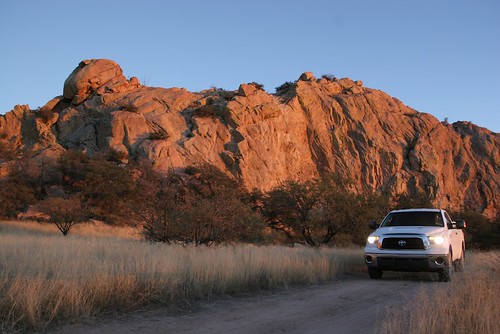 The 2008 Tundra . . . shrug.
The 2008 Tundra . . . shrug.
I’ve been about as loyal a Toyota fan as one could imagine for a long, long time. My first car was a 1971 Corolla with the nifty little overachiever 1600cc hemi-head engine. The car was chosen, to be honest, as much to annoy my stepfather (who still referred to people from the islands as “Nips”) as for any practical reason. The fact that that second-hand car proved spectacularly reliable in contrast to the new Ford Pinto station wagon my mother had at the time just made it so much sweeter. With suspension from the infant Toyota Racing Development and a set of Weber carbs, my Corolla embarrassed many a BMW 2002 and Z-car on Mt. Lemmon Highway.
In 1978 I bought the ’73 FJ40 that is still with me 300,000 miles later. Nuff said. And there has been a succession of Toyota pickups culminating in the 2012 Tacoma Roseann and I now have. All have been as reliable as the Corolla. The 2000 Tacoma we had under our first Four Wheel Camper required no repairs in 160,000 miles. Zero. So I’ve come to expect, and have enjoyed, utter dependability from the company’s products.
Innovation? Lately, not so much—at least if we’re discussing full-size trucks.
I remember the buzz surrounding the announcement of Toyota’s first “full-size” truck, the T-100, in 1993. When it finally arrived, officials at Ford and GM must have breathed a sigh of relief, if they didn’t laugh out loud—it wasn’t full-sized, and the base engine was . . . a four-cylinder? While the T100 proved as reliable as other Toyotas, and acceptably powerful with the optional V6, it was clearly a false start. So in 1999, its successor was announced with much fanfare and a proper full-size-truck name: the Tundra, as big as all outdoors.
Except, of course, it wasn’t. Yes, it was bigger than the T100, the four-cylinder was gone in favor of a base V6 and an optional proper V8, but the Tundra remained firmly in the unofficial mid-sized truck category. Again it was a workhorse—I know owners with 300,000-mile examples that have never been touched—but it did nothing to directly challenge American hegemony in the big-truck market.
Cue 2007. The second generation Tundra arrived, and . . . it was big. At last Toyota had a genuine full-sized truck, positioned to compete head-on with the best from Ford, GM, and Chrysler. Three hundred eighty horsepower, a 10,000-pound tow rating, available eight-foot bed. Watch out, Big Three.
Or not. I had a chance to review a four-wheel-drive standard-cab Tundra with the 5.7-liter V8 in 2008. There was no denying its impressive size—far too large for my tastes unless I’d also had my dream sailboat to tow with it. But it stood shoulder to shoulder with American trucks, and had the paper specs to compete.
In looking at the window sticker for features, I noticed the chassis described as a “Triple-Tech Frame,” which I assumed was a reference to an updated version of Toyota’s typical fully boxed chassis construction. I peered under the bed, and did a double take. There was no boxing at all under the bed, and only token bits under the front. This was a cheap open C-channel frame that would have looked right at home under a ’73 Ford pickup—the ones you see with side chrome strips about three inches apart where the cab meets the bed. As my English friends would say, I was gobsmacked. For years I’d been preaching the superiority of Toyota’s chassis construction, and here they’d abandoned it for 50-year-old technology and a fancy name. (My impressions were confirmed by THIS alarming video. Just watch it.)
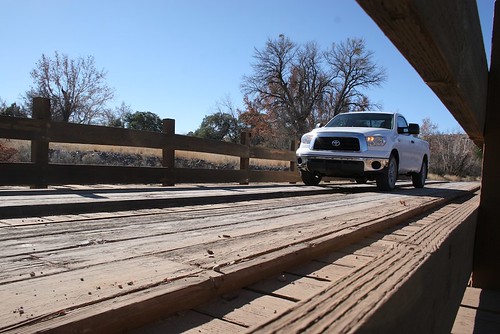
I spent a week with the truck, and . . . it worked just fine. The power was impressive, ride and handling were decent, the interior was okay, if short of the perfect ergonomics I associated with the company (perhaps because I just felt like a Hobbit perched on the seat). Ground clearance was comically inadequate; front air dam contact was inevitable on any but the mildest trail.
When I turned in the keys, I found that my overall reaction to this, Toyota’s broadside at the best-selling vehicles in the United States, its weapon to muscle in on the most iconic American object there is, the pickup truck, was . . . a shrug of the shoulders. There was nothing—simply nothing—I could see that would convince a loyal owner of an American truck to switch brands. No breakthroughs in technology, power, comfort, or economy. If Toyota expected to gain any market share at all except from a relative few owners of small Toyota pickups who found themselves needing a larger one, I predicted failure. Indeed, by 2012 Toyota’s share of the full-size truck market was stuck in the mud at around six percent. (Meanwhile the Tacoma commands well over 50 percent of the compact truck market in the U.S., outselling its nearest competitor by two to one.)
In the last couple of years there has been an avalanche of news about redesigned full-size trucks, with stunning advancements in technology. RAM introduced a sophisticated coil-spring rear suspension and announced a new turbodiesel engine that should catapult fuel economy figures into the high 20s. And Ford has completely rewritten the full-size-truck rule book with its 2015 F150, which will incorporate extensive use of aluminum, including the cab and bed. Incidentally, the chassis of that F150 is not only fully boxed, the crossmembers extend all the way through the boxed side rails and are welded on both sides. Now that’s the way to build a truck frame.
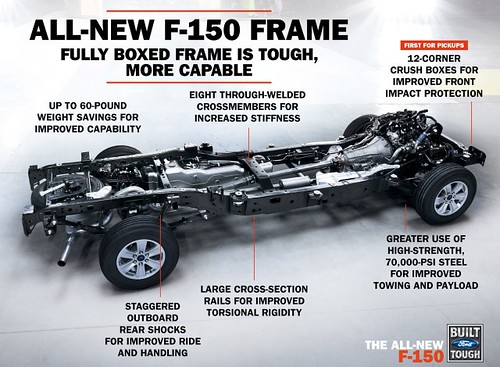
Along the way, I got a news item regarding the redesigned 2014 Tundra. Would this be the one? I clicked on the item, and found that the 2014 Tundra had indeed been thoroughly worked over, end to end.
Or rather, end and end: It had a new grille. And “TUNDRA” is now embossed on the tailgate, in letters as big as all outdoors.
In between? Pretty much zip.
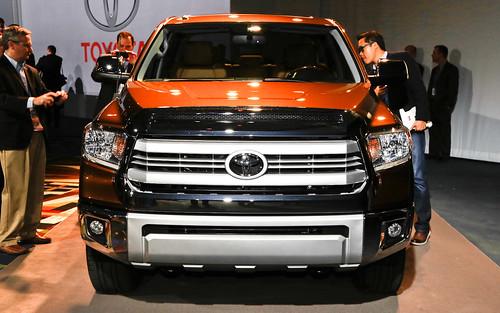 Thanks, Toyota.
Thanks, Toyota.
There’s a crude colloquial expression I could use here to urge Toyota to either get serious with the Tundra or abandon the segment altogether, but I’ll refrain. Nevertheless, I think the company needs to do one or the other.
 What it should have been.
What it should have been.
Hmm . . . HERE is an intriguing bit of news, courtesy my friend Bill Lee. A five-liter turbodiesel option would solve half my problem with the Tundra. A decent chassis would solve the other half . . .
The JATAC: A self-contained, solar-powered expedition vehicle
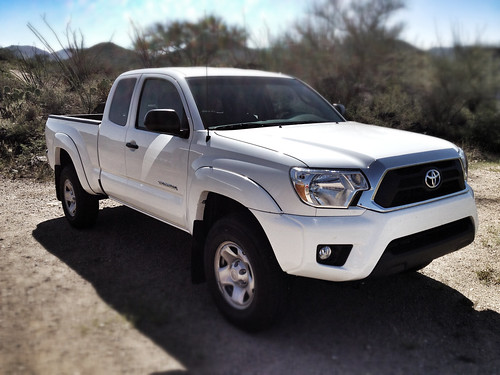 It's just a Tacoma—affordable, capable, reliable.There’s absolutely nothing exotic about our new Toyota Tacoma and Four Wheel Camper—that’s exactly why we chose the combination.
It's just a Tacoma—affordable, capable, reliable.There’s absolutely nothing exotic about our new Toyota Tacoma and Four Wheel Camper—that’s exactly why we chose the combination.
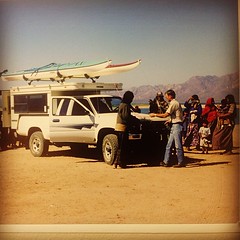 Our 1993 FWC Eagle and Toyota truck in Mexico.Our first Tacoma/FWC proved to be very nearly our ideal traveling arrangement, combining a capable, comfortable, and reliable truck with a compact home-away-from-home camper that deployed in 60 seconds, subtracted almost nothing from the off-pavement ability of the Tacoma, and provided everything we needed for long journeys away from civilization.
Our 1993 FWC Eagle and Toyota truck in Mexico.Our first Tacoma/FWC proved to be very nearly our ideal traveling arrangement, combining a capable, comfortable, and reliable truck with a compact home-away-from-home camper that deployed in 60 seconds, subtracted almost nothing from the off-pavement ability of the Tacoma, and provided everything we needed for long journeys away from civilization.
As I said to Roseann, the new combination is familiar, but feels like our old rig had won a spot on Xtreme Truck and Camper Makeover. The 2012 Tacoma is bigger and more powerful than the 2000 model, yet looks on track to deliver equivalent fuel economy, thanks to modern computer engineering. The camper is larger as well, and has been upgraded extensively since our 1993 version. Pressure water (totalling 26 gallons including the, heh, water heater), a cunning interior shower arrangement, a vastly more efficient compressor-driven fridge, and a front-mounted dinette that leaves the entire galley free for the cook are just a few benefits. It retains the gargantuo bed, sink, two-burner stove, and a tucked-away porta-potti for occasional use in crowded campsites or villages.
However, our needs and plans have evolved somewhat in the last decade, so we have several projects in mind or in process to suit our requirements:
- Since we work in electronic media now (laptop computers, cameras, video), we wanted an electrical system that would be essentially self-sufficient, able to handle the demands of the fridge and lights in the camper, power the laptops with 120-volt AC, and also do recharging duty for the cameras.
- Since we often travel as a solo vehicle, we wanted a truck that was not only capable in four-wheel-drive terrain, but completely self-sufficient in terms of recovery equipment and accessories.
- Lastly, we frequently combine camping with work, which can mean meetings in cities. We expect to be able to present ourselves properly—dressed well and not trailing an odor like, well, people who’ve been camping for a week.
 Just a Tacoma . . . and a camper. Newly installed Fleet at Four Wheel Campers.The solution to the first challenge will involve designing and installing a comprehensive solar-power system, a suitable battery bank and charge controller, and a reliable inverter to provide 120V AC when needed. It also entails ensuring the electrical systems in the camper (lights, etc.) are as efficient as possible.
Just a Tacoma . . . and a camper. Newly installed Fleet at Four Wheel Campers.The solution to the first challenge will involve designing and installing a comprehensive solar-power system, a suitable battery bank and charge controller, and a reliable inverter to provide 120V AC when needed. It also entails ensuring the electrical systems in the camper (lights, etc.) are as efficient as possible.
Addressing the second issue will include adding traction control in the form of a rear locker, ensuring the suspension retains compliance while carrying the extra load properly, and adding a winch and recovery points, along with the tools and accessories needed to augment the winch and allow for such needs as tire repair.
The third issue has been resolved—the shower and hot water system are brilliant for such a small unit.
We will be debuting the JATAC at Overland Expo 2013, and in the meantime I'll be posting updates on the modest modifications we have planned, including suspension from BOSS and ICON, new tires, front and rear bumpers, and mounting points for Hi-Lift and other tools.
[Special thanks goes to project co-sponsors Findlay Toyota of Flagstaff and Four Wheel Campers; we will be naming other sponsors as they join our project.]
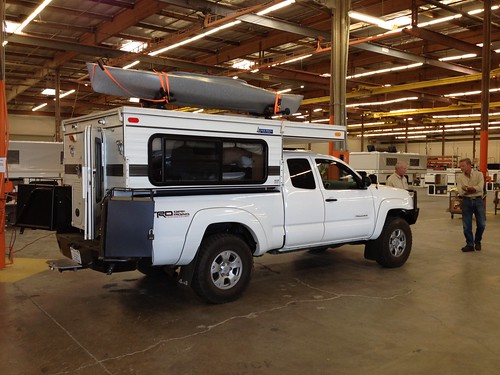 The inspiration for the new project: Tom Hanagan's 2012 Tacoma and earlier Fleet model. Ours has a newer configuration.
The inspiration for the new project: Tom Hanagan's 2012 Tacoma and earlier Fleet model. Ours has a newer configuration.
Land Cruisers of Baharia, Egypt
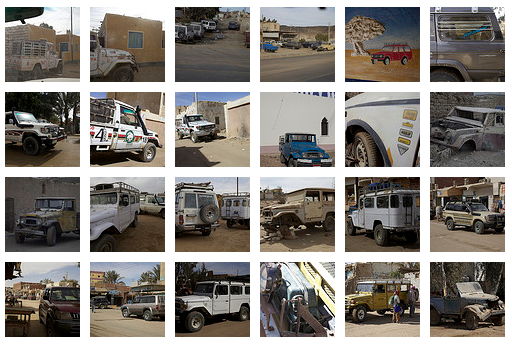 Land Cruisers of Baharia, Egypt—a set on Flickr
Land Cruisers of Baharia, Egypt—a set on Flickr
The oasis of Baharia, about five hours south of Cairo, is the gateway to the Western Deserts and a major hub for expedition services and vehicles.
On our way there during the Sykes-MacDougal Centennial Expedition in February 2012, we heard there was a booming trade in all things Land Cruisers, but we were not prepared for the sheer numbers of every year and model.
There were plenty of new, expensive examples, but there were many custom amalgamations that sometimes boggled the mind. Apparently, to avoid the high import duties on any vehicle (new or used), canny Egyptian mechanics in Baharia started bringing in cut-up halves and quarters of Land Cruisers from neighboring countries, and then welding them back together after arrival—voila, a duty-free Land Cruiser.
These photos were taken in just one day plus part of a morning, not even a full 8 hours in the town during daylight. There were hundreds—literally half the vehicles in town were Land Cruisers. Almost all the images are snapshots, taken out the window as we drove or shot quickly while walking. I included a couple of interesting non-Toyota shots.
Hint: When using “Search,” if nothing comes up, reload the page, this usually works. Also, our “Comment” button is on strike thanks to Squarespace, which is proving to be difficult to use! Please email me with comments!
Overland Tech & Travel brings you in-depth overland equipment tests, reviews, news, travel tips, & stories from the best overlanding experts on the planet. Follow or subscribe (below) to keep up to date.
Have a question for Jonathan? Send him an email [click here].
SUBSCRIBE
CLICK HERE to subscribe to Jonathan’s email list; we send once or twice a month, usually Sunday morning for your weekend reading pleasure.
Overland Tech and Travel is curated by Jonathan Hanson, co-founder and former co-owner of the Overland Expo. Jonathan segued from a misspent youth almost directly into a misspent adulthood, cleverly sidestepping any chance of a normal career track or a secure retirement by becoming a freelance writer, working for Outside, National Geographic Adventure, and nearly two dozen other publications. He co-founded Overland Journal in 2007 and was its executive editor until 2011, when he left and sold his shares in the company. His travels encompass explorations on land and sea on six continents, by foot, bicycle, sea kayak, motorcycle, and four-wheel-drive vehicle. He has published a dozen books, several with his wife, Roseann Hanson, gaining several obscure non-cash awards along the way, and is the co-author of the fourth edition of Tom Sheppard's overlanding bible, the Vehicle-dependent Expedition Guide.

